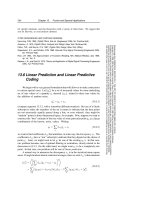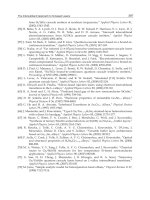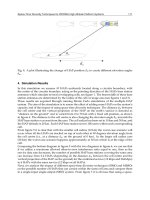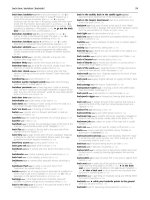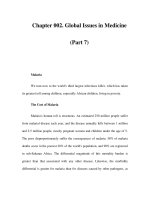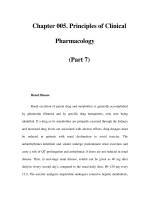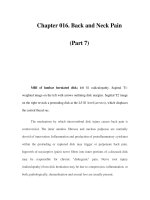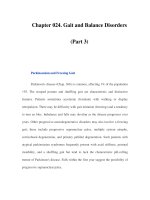Chapter 072. Malnutrition and Nutritional Assessment (Part 7) pptx
Bạn đang xem bản rút gọn của tài liệu. Xem và tải ngay bản đầy đủ của tài liệu tại đây (21.02 KB, 6 trang )
Chapter 072. Malnutrition and
Nutritional Assessment
(Part 7)
Assessment of Circulating (Visceral) Proteins
The serum proteins most used to assess nutritional status include albumin,
total iron-binding capacity (or transferrin), thyroxine-binding prealbumin (or
transthyretin), and retinol-binding protein. Because they have differing synthesis
rates and half-lives—the half-life of serum albumin is about 21 days whereas those
of prealbumin and retinol-binding protein are about 2 days and 12 h,
respectively—some of these proteins reflect changes in nutritional status more
quickly than others. However, rapid fluctuations can also make shorter-half-life
proteins less reliable.
Levels of circulating proteins are influenced by their rates of synthesis and
catabolism, "third spacing" (loss into interstitial spaces), and, in some cases,
external loss. Although an adequate intake of calories and protein is necessary to
achieve optimal circulating protein levels, serum protein levels generally do not
reflect protein intake. For example, a drop in the serum level of albumin or
transferrin often accompanies significant physiologic stress (e.g., from infection or
injury) and is not necessarily an indication of malnutrition or poor intake. A low
serum albumin level in a burned patient with both hypermetabolism and increased
dermal losses of protein may not indicate malnutrition. On the other hand,
adequate nutritional support of the patient's calorie and protein needs is critical for
returning circulating proteins to normal levels as stress resolves. Thus low values
by themselves do not define malnutrition, but they often point to increased risk of
malnutrition because of the hypermetabolic stress state. As long as significant
physiologic stress persists, serum protein levels remain low, even with aggressive
nutritional support. However, if the levels do not rise after the underlying illness
improves, the patient's protein and calorie needs should be reassessed to ensure
that intake is sufficient.
Assessment of Vitamin and Mineral Status
The use of laboratory tests to confirm suspected micronutrient deficiencies
is desirable because the physical findings for these are often equivocal or
nonspecific. Low blood micronutrient levels can predate more serious clinical
manifestations and may also indicate drug-nutrient interactions.
Estimating Energy and Protein Requirements
A patient's basal energy expenditures (BEE, measured in kilocalories per
day) can be estimated from height, weight, age, and gender using the Harris-
Benedict equations:
where W is weight in kg; H is height in cm, and A is age in years. After
solving these equations, total energy requirements are estimated by multiplying
the BEE by a factor that accounts for the stress of illness. Multiplying by 1.1–1.4
yields a range 10–40% above basal that estimates the 24-h energy expenditure of
the majority of patients. The lower value (1.1) is used for patients without
evidence of significant physiologic stress; the higher value (1.4) is appropriate for
patients with marked stress such as sepsis or trauma. The result is used as a 24-h
energy goal for feeding.
When it is important to have a more accurate assessment of energy
expenditure, it can be measured at the bedside using indirect calorimetry. This
technique is useful in patients who are believed to be hypermetabolic from sepsis
or trauma and whose body weights cannot be obtained accurately. Indirect
calorimetry can also be useful in patients having difficulty weaning from a
ventilator, as their energy needs should not be exceeded to avoid excessive CO
2
production. Patients at the extremes of weight (e.g., obese persons) and/or age are
good candidates as well, because the Harris-Benedict equations were developed
from measurements in adults with roughly normal body weights.
Because urea is a major byproduct of protein catabolism, the amount of
urea nitrogen excreted each day can be used to estimate the rate of protein
catabolism and to determine if protein intake is adequate to offset it. Total protein
loss and protein balance can be calculated from the urinary urea nitrogen (UUN)
as follows:
The value of 4 g added to the UUN represents a liberal estimate of the
unmeasured nitrogen lost in the urine (e.g., creatinine and uric acid), sweat, hair,
skin, and feces. When protein intake is low (e.g., less than about 20 g/d), the
equation indicates both the patient's protein requirement and the severity of the
catabolic state (Table 72-5). More substantial protein intakes can raise the UUN
because some of the ingested (or infused) protein is catabolized and converted to
UUN. Thus at lower protein intakes the equation is useful for estimating
requirements, and at higher protein intakes it is useful for assessing protein
balance.
Further Readings
American Society for Parenteral and Enteral Nutrition:
The science and
practice of nutrition support: A case
-based core curriculum.
Dubuque,
Kendall/Hunt, 2001. Available online at: www.nutritioncare.org
Baker H: Nutrition in the elderly: Hypovitaminosis and its implications.
Geriatrics 62(8):22, 2007
Chapman IM: Nutritional disorders in the elde
rly. Med Clin North Am
90(5):887, 2006
Heimburger DC, Ard JD (eds): Handbook of Clinical Nutrition,
4th ed.
Philadelphia, Mosby Elsevier, 2006
Shils ME et al (eds): Modern Nutrition in Health and Disease
, 10th ed.
Baltimore, Lippincott Williams & Wilkins, 2005
